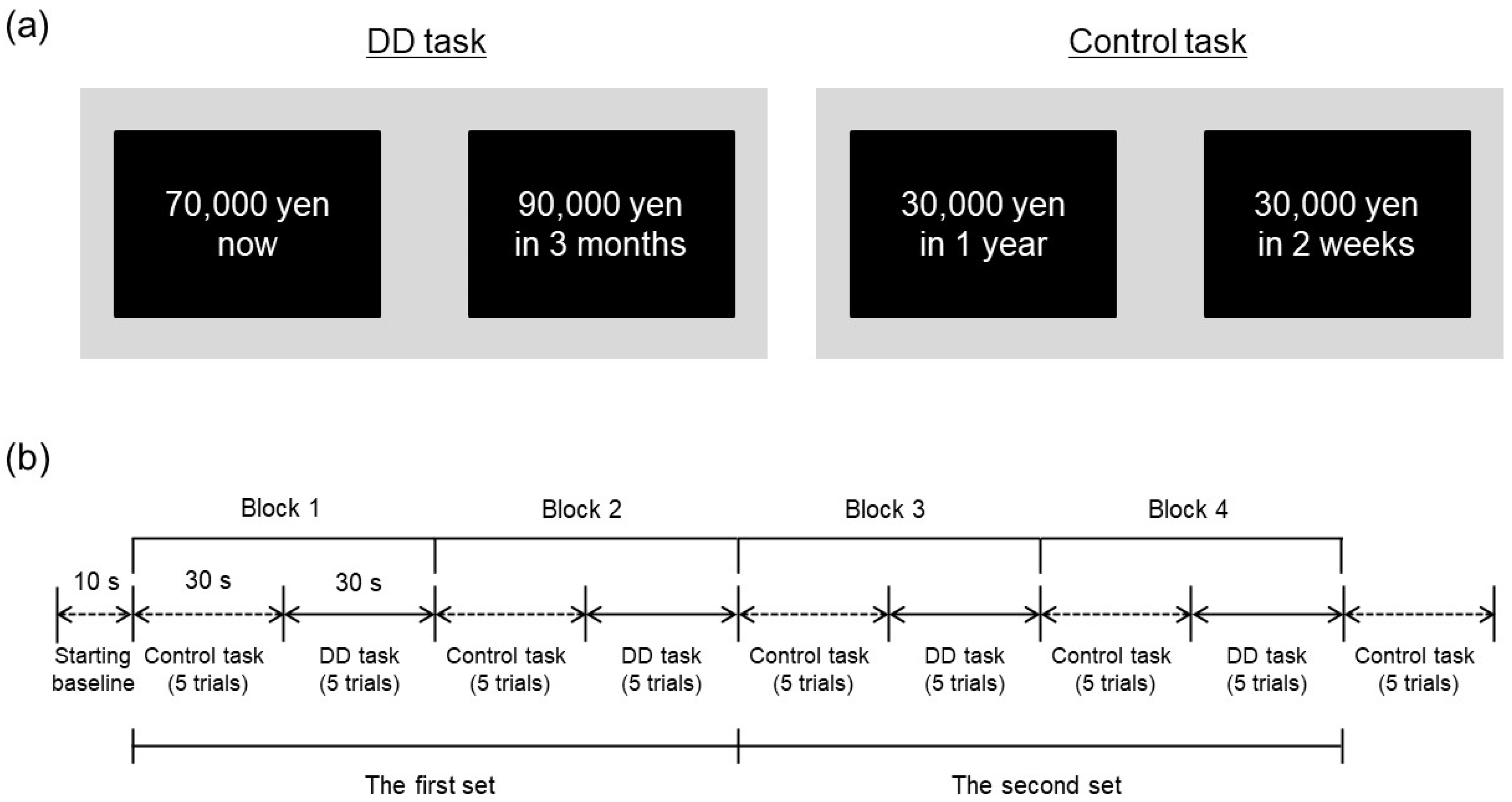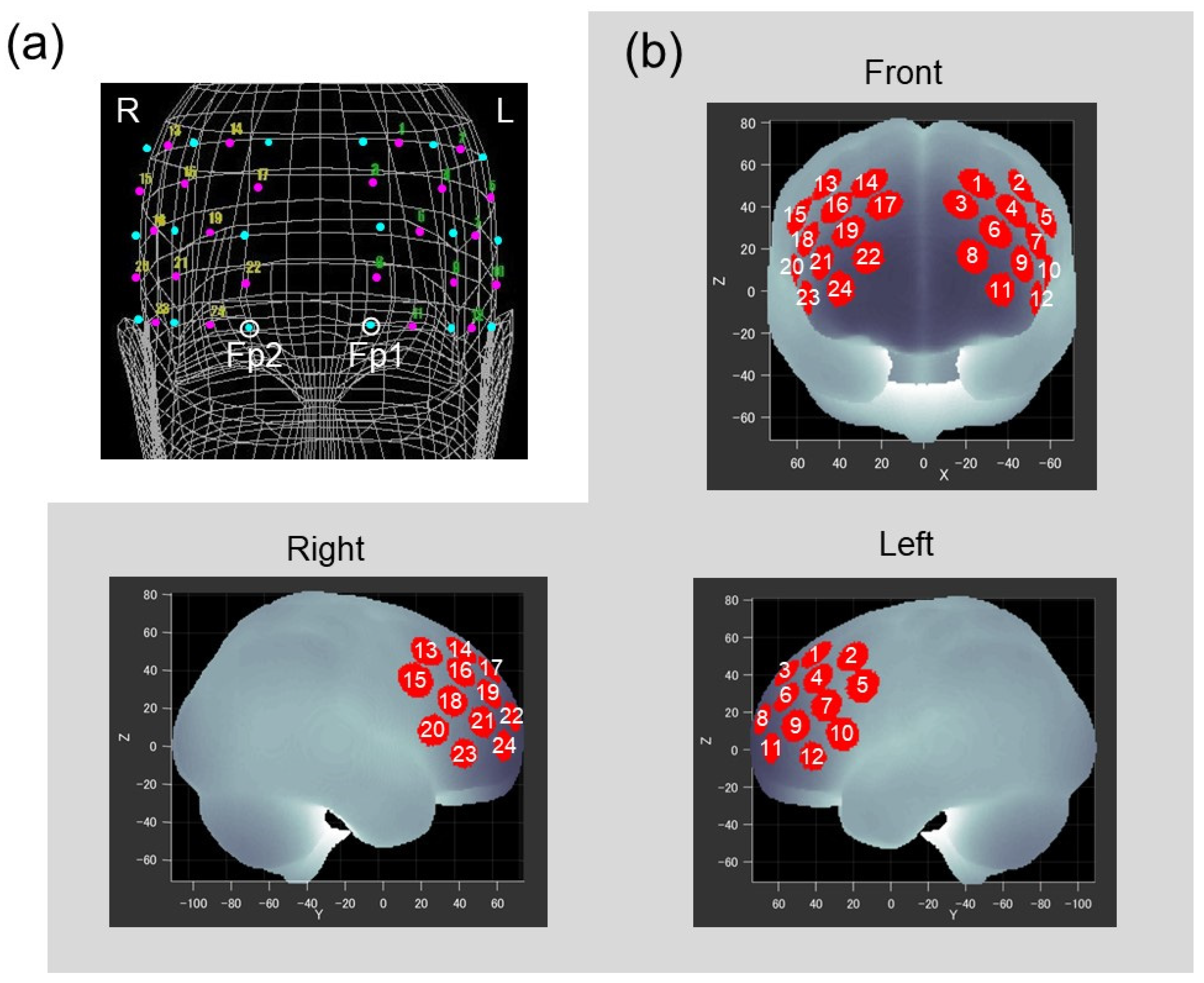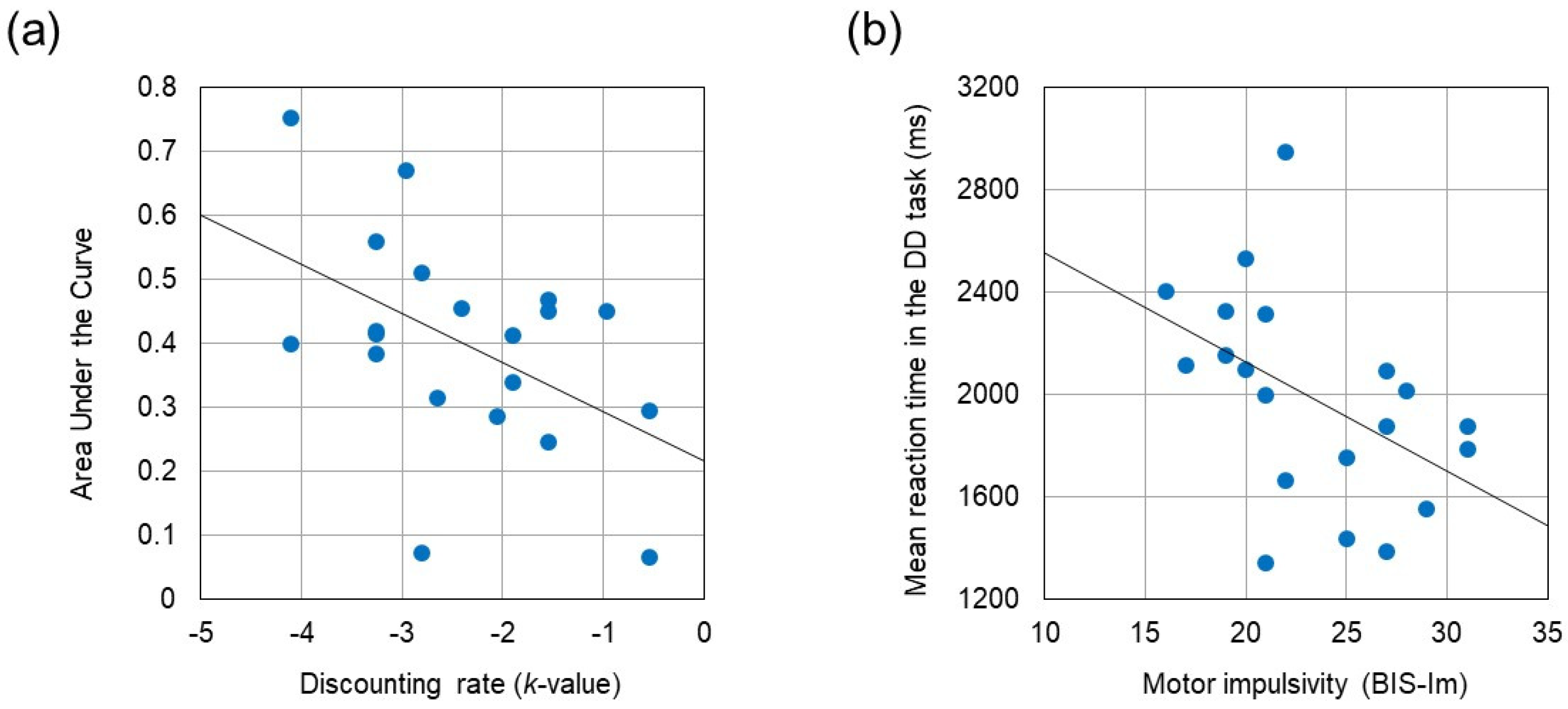Differential Neural Correlates in the Prefrontal Cortex during a Delay Discounting Task in Healthy Adults: An fNIRS Study
Abstract
:1. Introduction
2. Materials and Methods
2.1. Participants
2.2. DD Task
2.3. Questionnaires to Assess Impulsivity
2.4. fNIRS Data Acquisition
2.5. Data Analyses
3. Results
3.1. Behavioral Performances and Questionnaires
3.2. fNIRS Data
4. Discussion
5. Conclusions
Author Contributions
Funding
Institutional Review Board Statement
Informed Consent Statement
Data Availability Statement
Conflicts of Interest
References
- Kirby, K.N.; Petry, N.M. Heroin and cocaine abusers have higher discount rates for delayed rewards than alcoholics or non-drug-using controls. Addiction 2004, 99, 461–471. [Google Scholar] [CrossRef] [PubMed]
- Logue, A.W. Research on self-control: An integrating framework. Behav. Brain Sci. 1988, 11, 665–709. [Google Scholar] [CrossRef]
- Kirby, K.N.; Winston, G.C.; Santiesteban, M. Impatience and grades: Delay-discount rates correlate negatively with college GPA. Learn Individ. Differ. 2005, 15, 213–222. [Google Scholar] [CrossRef]
- Barlow, P.; Reeves, A.; McKee, M.; Galea, G.; Stuckler, D. Unhealthy diets, obesity and time discounting: A systematic literature review and network analysis. Obes. Rev. 2016, 17, 810–819. [Google Scholar] [CrossRef]
- Dennis, L.E.; Kohno, M.; McCready, H.D.; Schwartz, D.L.; Schwartz, B.; Lahna, D.; Nagel, B.J.; Mitchell, S.H.; Hoffman, W.F. Neural correlates of reward magnitude and delay during a probabilistic delay discounting task in alcohol use disorder. Psychopharmacology 2020, 237, 263–278, Erratum in Psychopharmacology 2020, 237, 239. [Google Scholar] [CrossRef]
- Weinsztok, S.; Brassard, S.; Balodis, I.; Martin, L.E.; Amlung, M. Delay discounting in established and proposed behavioral addictions: A systematic review and meta-analysis. Front. Behav. Neurosci. 2021, 15, 786358. [Google Scholar] [CrossRef]
- Jackson, J.N.; MacKillop, J. Attention-deficit/hyperactivity disorder and monetary delay discounting: A meta-analysis of case-control studies. Biol Psychiatry Cogn. Neurosci. Neuroimaging. 2016, 1, 316–325. [Google Scholar] [CrossRef]
- Patros, C.H.; Alderson, R.M.; Kasper, L.J.; Tarle, S.J.; Lea, S.E.; Hudec, K.L. Choice-impulsivity in children and adolescents with attention-deficit/hyperactivity disorder (ADHD): A meta-analytic review. Clin. Psychol. Rev. 2016, 43, 162–174. [Google Scholar] [CrossRef]
- Warnell, K.R.; Maniscalco, S.; Baker, S.; Yi, R.; Redcay, E. Social and delay discounting in autism spectrum disorder. Autism Res. 2019, 12, 870–877. [Google Scholar] [CrossRef]
- Demurie, E.; Roeyers, H.; Baeyens, D.; Sonuga-Barke, E. Temporal discounting of monetary rewards in children and adolescents with ADHD and autism spectrum disorders. Dev. Sci. 2012, 15, 791–800. [Google Scholar] [CrossRef]
- Ikegami, M.; Araki, A.; Masuyama, Y.; Sorama, M.; Saeki, D.; Okumura, K.; Takahashi, M. Delay discounting of monetary rewards in children with attention-deficit/hyperactivity disorder and autism spectrum disorder. Psychiatr. Neurol. Paediatr. Jpn. 2020, 60, 223–231, (In Japanese with English abstract). [Google Scholar] [CrossRef]
- Sonuga-Barke, E.; Bitsakou, P.; Thompson, M. Beyond the dual pathway model: Evidence for the dissociation of timing, inhibitory, and delay-related impairments in attention-deficit/hyperactivity disorder. J. Am. Acad. Child Adolesc. Psychiatry 2010, 49, 345–355. [Google Scholar] [CrossRef] [PubMed]
- Peters, J.; Büchel, C. The neural mechanisms of inter-temporal decision-making: Understanding variability. Trends Cogn. Sci. 2011, 15, 227–239. [Google Scholar] [CrossRef] [PubMed]
- Kable, J.W.; Glimcher, P.W. The neural correlates of subjective value during intertemporal choice. Nat. Neurosci. 2007, 10, 1625–1633. [Google Scholar] [CrossRef]
- Ballard, K.; Knutson, B. Dissociable neural representations of future reward magnitude and delay during temporal discounting. Neuroimage 2009, 45, 143–150. [Google Scholar] [CrossRef]
- McClure, S.M.; Laibson, D.I.; Loewenstein, G.; Cohen, J.D. Separate neural systems value immediate and delayed monetary rewards. Science 2004, 306, 503–507. [Google Scholar] [CrossRef]
- Hare, T.A.; Camerer, C.F.; Rangel, A. Self-control in decision-making involves modulation of the vmPFC valuation system. Science 2009, 324, 646–648. [Google Scholar] [CrossRef]
- Figner, B.; Knoch, D.; Johnson, E.J.; Krosch, A.R.; Lisanby, S.H.; Fehr, E.; Weber, E.U. Lateral prefrontal cortex and self-control in intertemporal choice. Nat. Neurosci. 2010, 13, 538–539. [Google Scholar] [CrossRef]
- Bickel, W.K.; Jarmolowicz, D.P.; Mueller, E.T.; Gatchalian, K.M.; McClure, S.M. Are executive function and impulsivity antipodes? A conceptual reconstruction with special reference to addiction. Psychopharmacology 2012, 221, 361–387. [Google Scholar] [CrossRef]
- Wesley, M.J.; Bickel, W.K. Remember the future II: Meta-analyses and functional overlap of working memory and delay discounting. Biol. Psychiatry. 2014, 75, 435–448. [Google Scholar] [CrossRef]
- Benoit, R.G.; Gilbert, S.J.; Burgess, P.W. A neural mechanism mediating the impact of episodic prospection on farsighted decisions. J. Neurosci. 2011, 31, 6771–6779. [Google Scholar] [CrossRef] [PubMed]
- Peters, J.; Büchel, C. Episodic future thinking reduces reward delay discounting through an enhancement of prefrontal-mediotemporal interactions. Neuron 2010, 66, 138–148. [Google Scholar] [CrossRef] [PubMed]
- McClure, S.M.; Bickel, W.K. A dual-systems perspective on addiction: Contributions from neuroimaging and cognitive training. Ann. N. Y. Acad. Sci. 2014, 1327, 62–78, Erratum in Ann. N. Y. Acad. Sci. 2014, 1328, 35. [Google Scholar] [CrossRef]
- Kozak, K.; Lucatch, A.M.; Lowe, D.J.E.; Balodis, I.M.; MacKillop, J.; George, T.P. The neurobiology of impulsivity and substance use disorders: Implications for treatment. Ann. N. Y. Acad. Sci. 2019, 1451, 71–91. [Google Scholar] [CrossRef] [PubMed]
- Allenby, C.; Falcone, M.; Bernardo, L.; Wileyto, E.P.; Rostain, A.; Ramsay, J.R.; Lerman, C.; Loughead, J. Transcranial direct current brain stimulation decreases impulsivity in ADHD. Brain Stimul. 2018, 11, 974–981. [Google Scholar] [CrossRef] [PubMed]
- Scheres, A.; de Water, E.; Mies, G.W. The neural correlates of temporal reward discounting. Wiley Interdiscip. Rev. Cogn. Sci. 2013, 4, 523–545. [Google Scholar] [CrossRef] [PubMed]
- Araki, A.; Ikegami, M.; Okayama, A.; Matsumoto, N.; Takahashi, S.; Azuma, H.; Takahashi, M. Improved prefrontal activity in AD/HD children treated with atomoxetine: A NIRS study. Brain Dev. 2015, 37, 76–87. [Google Scholar] [CrossRef]
- Kirby, K.N.; Maraković, N.N. Delay-discounting probabilistic rewards: Rates decrease as amounts increase. Psychon. Bull. Rev. 1996, 3, 100–104. [Google Scholar] [CrossRef]
- Oldfield, R.C. The assessment and analysis of handedness: The Edinburgh inventory. Neuropsychologia 1971, 9, 97–113. [Google Scholar] [CrossRef]
- Saeki, D. Self-control and impulsivity from the viewpoint of temporal discounting. In Psychology of Self-Control; Takahashi, M., Ed.; Kitaohji-Shobo: Kyoto, Japan, 2017; pp. 23–38. (In Japanese) [Google Scholar]
- Green, L.; Myerson, J. A discounting framework for choice with delayed and probabilistic rewards. Psychol. Bull. 2004, 130, 769–792. [Google Scholar] [CrossRef]
- Hoffman, W.F.; Schwartz, D.L.; Huckans, M.S.; McFarland, B.H.; Meiri, G.; Stevens, A.A.; Mitchell, S.H. Cortical activation during delay discounting in abstinent methamphetamine dependent individuals. Psychopharmacology 2008, 201, 183–193. [Google Scholar] [CrossRef] [PubMed]
- Myerson, J.; Green, L.; Warusawitharana, M. Area under the curve as a measure of discounting. J. Exp. Anal. Behav. 2001, 76, 235–243. [Google Scholar] [CrossRef] [PubMed]
- Rachlin, H.; Raineri, A.; Cross, D. Subjective probability and delay. J. Exp. Anal. Behav. 1991, 55, 233–244. [Google Scholar] [CrossRef] [PubMed]
- Hiraoka, K. Gambling and Delay Discounting in Japanese Students. Jpn. Psychol. Res. 2018, 60, 156–161. [Google Scholar] [CrossRef]
- Someya, T.; Sakado, K.; Seki, T.; Kojima, M.; Reist, C.; Tang, S.W.; Takahashi, S. The Japanese version of the Barratt Impulsiveness Scale, 11th version (BIS-11): Its reliability and validity. Psychiatry Clin. Neurosci. 2001, 55, 111–114. [Google Scholar] [CrossRef]
- Patton, J.H.; Stanford, M.S.; Barratt, E.S. Factor structure of the Barratt impulsiveness scale. J. Clin. Psychol. 1995, 51, 768–774. [Google Scholar] [CrossRef]
- Takahashi, M.; Ikegami, M. Differential frontal activation during exogenous and endogenous orientation of visuospatial attention. A near-infrared spectroscopy study. Neuropsychobiology 2008, 58, 55–64. [Google Scholar] [CrossRef]
- Toronov, V.; Webb, A.; Choi, J.H.; Wolf, M.; Michalos, A.; Gratton, E.; Hueber, D. Investigation of human brain hemodynamics by simultaneous near-infrared spectroscopy and functional magnetic resonance imaging. Med. Phys. 2001, 28, 521–527. [Google Scholar] [CrossRef]
- Singh, A.K.; Okamoto, M.; Dan, H.; Jurcak, V.; Dan, I. Spatial registration of multichannel multi-subject fNIRS data to MNI space without MRI. Neuroimage 2005, 27, 842–851. [Google Scholar] [CrossRef]
- Collins, D.L.; Neelin, P.; Peters, T.M.; Evans, A.C. Automatic 3D intersubject registration of MR volumetric data in standardized Talairach space. J. Comput. Assist. Tomogr. 1994, 18, 192–205. [Google Scholar] [CrossRef]
- Khan, B.; Wildey, C.; Francis, R.; Tian, F.; Delgado, M.R.; Liu, H.; Macfarlane, D.; Alexandrakis, G. Improving optical contact for functional near-infrared brain spectroscopy and imaging with brush optodes. Biomed. Opt. Express. 2012, 3, 878–898. [Google Scholar] [CrossRef] [PubMed]
- Reynolds, B.; Ortengren, A.; Richards, J.B.; de Wit, H. Dimensions of impulsive behavior: Personality and behavioral measures. Personality and Individual Differences. 2006, 40, 305–315. [Google Scholar] [CrossRef]
- van der Laan, L.N.; Barendse, M.E.A.; Viergever, M.A.; Smeets, P.A.M. Subtypes of trait impulsivity differentially correlate with neural responses to food choices. Behav. Brain Res. 2016, 296, 442–450. [Google Scholar] [CrossRef]
- Green, L.; Myerson, J.; Lichtman, D.; Rosen, S.; Fry, A. Temporal discounting in choice between delayed rewards: The role of age and income. Psychol. Aging. 1996, 11, 79–84. [Google Scholar] [CrossRef] [PubMed]
- Yeh, Y.H.; Myerson, J.; Green, L. Delay discounting, cognitive ability, and personality: What matters? Psychon. Bull Rev. 2021, 28, 686–694. [Google Scholar] [CrossRef] [PubMed]
- Bartholdy, S.; Cheng, J.; Schmidt, U.; Campbell, I.C.; O’Daly, O.G. Task-based and questionnaire measures of inhibitory control are differentially affected by acute food restriction and by motivationally salient food stimuli in healthy adults. Front Psychol. 2016, 7, 1303. [Google Scholar] [CrossRef]
- Luhmann, C.C.; Chun, M.M.; Yi, D.J.; Lee, D.; Wang, X.J. Neural dissociation of delay and uncertainty in intertemporal choice. J. Neurosci. 2008, 28, 14459–14466. [Google Scholar] [CrossRef]
- Luo, S.; Ainslie, G.; Pollini, D.; Giragosian, L.; Monterosso, J.R. Moderators of the association between brain activation and farsighted choice. Neuroimage 2012, 59, 1469–1477. [Google Scholar] [CrossRef]
- Lv, C.; Wang, Q.; Chen, C.; Xue, G.; He, Q. Activation patterns of the dorsal medial prefrontal cortex and frontal pole predict individual differences in decision impulsivity. Brain Imaging Behav. 2021, 15, 421–429. [Google Scholar] [CrossRef]
- Smith, B.J.; Monterosso, J.R.; Wakslak, C.J.; Bechara, A.; Read, S.J. A meta-analytical review of brain activity associated with intertemporal decisions: Evidence for an anterior-posterior tangibility axis. Neurosci. Biobehav. Rev. 2018, 86, 85–98. [Google Scholar] [CrossRef]
- Shamosh, N.A.; Deyoung, C.G.; Green, A.E.; Reis, D.L.; Johnson, M.R.; Conway, A.R.; Engle, R.W.; Braver, T.S.; Gray, J.R. Individual differences in delay discounting: Relation to intelligence, working memory, and anterior prefrontal cortex. Psychol. Sci. 2008, 19, 904–911. [Google Scholar] [CrossRef] [PubMed]
- Hinson, J.M.; Jameson, T.L.; Whitney, P. Impulsive decision making and working memory. J. Exp. Psychol. Learn Mem. Cogn. 2003, 29, 298–306. [Google Scholar] [CrossRef] [PubMed]
- Haber, S.N.; Knutson, B. The reward circuit: Linking primate anatomy and human imaging. Neuropsychopharmacology 2010, 35, 4–26. [Google Scholar] [CrossRef] [PubMed]
- Bickel, W.K.; Pitcock, J.A.; Yi, R.; Angtuaco, E.J. Congruence of BOLD response across intertemporal choice conditions: Fictive and real money gains and losses. J. Neurosci. 2009, 29, 8839–8846. [Google Scholar] [CrossRef]
- Hinvest, N.S.; Elliott, R.; McKie, S.; Anderson, I.M. Neural correlates of choice behavior related to impulsivity and venturesomeness. Neuropsychologia 2011, 49, 2311–2320. [Google Scholar] [CrossRef]
- Chowdhury, N.S.; Livesey, E.J.; Blaszczynski, A.; Harris, J.A. Pathological Gambling and Motor Impulsivity: A Systematic Review with Meta-Analysis. J. Gambl.Stud. 2017, 33, 1213–1239. [Google Scholar] [CrossRef]
- Asahi, S.; Okamoto, Y.; Okada, G.; Yamawaki, S.; Yokota, N. Negative correlation between right prefrontal activity during response inhibition and impulsiveness: A fMRI study. Eur. Arch. Psychiatry Clin. Neurosci. 2004, 254, 245–251. [Google Scholar] [CrossRef] [PubMed]
- Gable, P.A.; Neal, L.B.; Threadgill, A.H. Regulatory behavior and frontal activity: Considering the role of revised-BIS in relative right frontal asymmetry. Psychophysiology 2018, 55. [Google Scholar] [CrossRef]
- Wang, Q.; Chen, C.; Cai, Y.; Li, S.; Zhao, X.; Zheng, L.; Zhang, H.; Liu, J.; Chen, C.; Xue, G. Dissociated neural substrates underlying impulsive choice and impulsive action. Neuroimage 2016, 134, 540–549. [Google Scholar] [CrossRef]
- Moccia, L.; Pettorruso, M.; De Crescenzo, F.; De Risio, L.; di Nuzzo, L.; Martinotti, G.; Bifone, A.; Janiri, L.; Di Nicola, M. Neural correlates of cognitive control in gambling disorder: A systematic review of fMRI studies. Neurosci. Biobehav. Rev. 2017, 78, 104–116. [Google Scholar] [CrossRef]
- Rubia, K.; Halari, R.; Christakou, A.; Taylor, E. Impulsiveness as a timing disturbance: Neurocognitive abnormalities in attention-deficit hyperactivity disorder during temporal processes and normalization with methylphenidate. Philos. Trans. R. Soc. Lond. B Biol. Sci. 2009, 364, 1919–1931. [Google Scholar] [CrossRef] [PubMed]





| Trial No. | Delay | k-Value |
|---|---|---|
| 1 | 1 day | 0.28571 |
| 2 | 1 week | 0.04082 |
| 3 | 2 weeks | 0.02041 |
| 4 | 1 month | 0.00952 |
| 5 | 3 months | 0.00317 |
| 6 | 6 months | 0.00159 |
| 7 | 1 year | 0.00078 |
| 8 | 2 years | 0.00039 |
| 9 | 5 years | 0.00016 |
| 10 | 10 years | 0.00008 |
| Behavioral Performances | Questionnaires | |||||
|---|---|---|---|---|---|---|
| RT (ms) | k-Value | AUC | BIS-Iat | BIS-Im | BIS-Inp | |
| DD task | 1984.0 ± 408.1 ** | −2.37 ± 1.06 | 0.40 ± 0.17 | 16.85 ± 3.84 | 23.40 ± 4.54 | 24.70 ± 3.99 |
| Control task | 1782.0 ± 307.9 | |||||
| RT (Control) | RT (DD) | k-Value | AUC | BIS-Iat | BIS-Im | BIS-Inp | |
|---|---|---|---|---|---|---|---|
| RT (control) | — | 0.892 ** | −0.048 | 0.265 | −0.298 | −0.564 ** | −0.349 |
| RT (DD) | — | −0.139 | 0.332 | −0.165 | −0.473 * | −0.311 | |
| k-value | — | −0.488 * | −0.142 | 0.075 | 0.215 | ||
| AUC | — | 0.342 | 0.072 | −0.234 | |||
| BIS-Iat | — | 0.469 * | 0.083 | ||||
| BIS-Im | — | 0.537 * | |||||
| BIS-Inp | — |
| MNI Coordinate | Brodmann Area Estimation | |||||
|---|---|---|---|---|---|---|
| X | Y | Z | SD (mm) | Brodmann Areas | % | |
| CH8 | −23.33 | 69.00 | 16.33 | 8.79 | 10—Frontopolar area | 100.00 |
| CH9 | −46.33 | 50.67 | 12.33 | 9.36 | 46—Dorsolateral prefrontal cortex | 75.55 |
| CH11 | −36.67 | 64.00 | 0.67 | 8.41 | 10—Frontopolar area | 86.60 |
| CH18 | 54.33 | 36.33 | 24.33 | 9.04 | 45—Pars triangularis Broca’s area | 100.00 |
| CH19 | 35.33 | 56.33 | 27.67 | 9.10 | 46—Dorsolateral prefrontal cortex | 98.43 |
| CH21 | 48.00 | 52.33 | 13.33 | 8.86 | 46—Dorsolateral prefrontal cortex | 91.30 |
| CH22 | 26.33 | 68.67 | 15.67 | 8.56 | 10—Frontopolar area | 100.00 |
| CH24 | 39.67 | 64.33 | 0.67 | 8.52 | 10—Frontopolar area | 82.90 |
Disclaimer/Publisher’s Note: The statements, opinions and data contained in all publications are solely those of the individual author(s) and contributor(s) and not of MDPI and/or the editor(s). MDPI and/or the editor(s) disclaim responsibility for any injury to people or property resulting from any ideas, methods, instructions or products referred to in the content. |
© 2023 by the authors. Licensee MDPI, Basel, Switzerland. This article is an open access article distributed under the terms and conditions of the Creative Commons Attribution (CC BY) license (https://creativecommons.org/licenses/by/4.0/).
Share and Cite
Ikegami, M.; Sorama, M. Differential Neural Correlates in the Prefrontal Cortex during a Delay Discounting Task in Healthy Adults: An fNIRS Study. Brain Sci. 2023, 13, 758. https://doi.org/10.3390/brainsci13050758
Ikegami M, Sorama M. Differential Neural Correlates in the Prefrontal Cortex during a Delay Discounting Task in Healthy Adults: An fNIRS Study. Brain Sciences. 2023; 13(5):758. https://doi.org/10.3390/brainsci13050758
Chicago/Turabian StyleIkegami, Masanaga, and Michiko Sorama. 2023. "Differential Neural Correlates in the Prefrontal Cortex during a Delay Discounting Task in Healthy Adults: An fNIRS Study" Brain Sciences 13, no. 5: 758. https://doi.org/10.3390/brainsci13050758
APA StyleIkegami, M., & Sorama, M. (2023). Differential Neural Correlates in the Prefrontal Cortex during a Delay Discounting Task in Healthy Adults: An fNIRS Study. Brain Sciences, 13(5), 758. https://doi.org/10.3390/brainsci13050758






